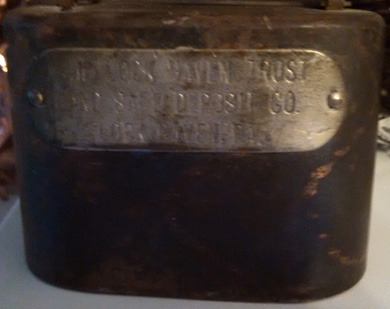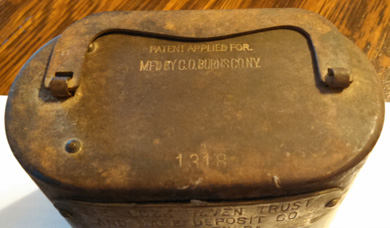 |
|
|||
 |
 |
|||
Copyright © Harry Rinker, LLC 2016 Questions
and Answers
QUESTION: My fiancé and I are young and love to go antiquing. We plan to drive down I-95 from Pennsylvania to Florida and were wondering what suggestions you have about antiquing down the east coast. It seems like there are thousands of places. We do not have the time to visit all of them. My fiancé is especially interested in antique tools and woodworking. What do you recommend? – LW, State College, PA, Email Question ANSWER: First, welcome to the wonderful world of antiquing. The field badly needs younger participants. You are wise to plan ahead. I suspect your time is limited. You are correct in assuming you will not have time to take advantage of all the antiquing opportunities found along I-95. My first recommendation is to focus on antiques malls located near I-95 exits. Avoid leaving I-95 and spending time in cities such as Charleston and Savannah. Set a limit of no more than ten miles off the highway. Check out The Great Big Flea Market in Richmond (www.greatbigflea.nova-antiques.com). The one side trip you might consider is going to Atlanta if your travel dates correspond with a Scott Antiques Market (36650 Jonesboro Road SE, Atlanta, GA 30354). Flea markets and shows are fun, but you will accomplish more if you focus on antiques malls. South of Washington, DC, major I-95 antiques malls usually advertise on billboards along the highway. Antiques malls offer your fiancé the best opportunity to find tools and other woodworking equipment. There is no national printed guide to antiques flea markets, shops, and shows. However, “Maine Antique Digest” and “AntiqueWeek” publish antiquing guides. While mostly focused on malls and shops north of the Mason-Dixon line and in the Midwest, some Southern establishments are included. Purchase copies for present and later use. Obtain copies of the periodicals – “Antique Shoppe Newspaper” (www.antiqueshoppefl.com), “Art & Antiques (www.artandantiquesmag.com), and “Southeastern Antiquing and Collecting Magazine” (www.go-star.com/antiquing/). The websites for “Antique Shoppe Newspaper” and “Southeastern Antiquing and Collecting Magazine” contain mall and shop guides. The difficulty is the listings consist of those malls and shops that advertise. Using internet guides is time consuming but profitable. The website www.antiquemalls.com requires you to pick a state and then select a town. It also has a “plan a trip” option that I recommend. I selected State College to Miami. The route appears to use I-95. Keep enlarging the route map until you can read the individual button numbers clearly. A word of warning: Beware of the antiques malls and shops along Route 1 and Route AIA in Florida. Based on my shopping experiences, reproductions (exact copies of period pieces) and copycats (stylistic copies of period pieces) abound. “Caveat Emptor” applies. Once in Florida and again if your travel dates correspond with the date of a Renninger’s Extravaganza in Mt. Dora, I encourage you to detour and go. Renninger’s Flea Market is open every weekend, but Extravaganza weekends are the best. Most Southern flea markets focus on used and discounted goods and not antiques and collectibles. They really should be called Swap Meets rather than flea markets. This is another reason to keep your focus on antiques malls. Finally, rather than seeing how many antiques malls or shops you can visit in a day, concentrate on three to five. Allow enough time to leisurely walk the aisles and examine the cases. A half-hour visit does not do justice to any antiques mall. After your antiquing trip to Florida, send me an email (harrylrinker@aol.com) and tell me about your experiences. I enjoy seeing the trade through the eyes of a young collector. QUESTION: I found an old bank box while searching through an attic. The oval shaped box is marked “PATENT APPLIED FOR / MFD BY C. O. BURNS CO., NY / 1318.” An attached plaque on the side read: “THE LOCK HAVEN TRUST / AND SAFE DEPOSIT CO. / LOCK HAVEN, PA.” The oval shaped box is in fair condition. What can you tell me about the history of the piece? – JP, Flemington, PA, Email Question
ANSWER: The Lock Haven Trust and Safe Deposit Company was organized in 1891. Henry T. Harvey served as president. Other officers included Charles Corss, solicitor, Jacob Scott, first vice president, Robert H. Hurst, second vice president, and Thomas R. Mann, secretary and treasurer. According to financial records available online, the institution operated into the 1910s. While I could find no reference to C. O. Burns, I did find information about the W. F. Burns Company, which made steel banks, some identical in shape to the bank box that you found, as well as numerous coin and currency storage units and strong boxes. In 1894, W. F. Burns acquired The International Money Box Company. Shortly, thereafter, W. F. Burns began manufacturing small advertising banks. By 1910, W. F. Burns had locations in Chicago and New York. In the mid-1920s, “The Burns Company” operated only from New York. See: www.thewsburns.com.
There is a strong secondary market for Burns steel metal banks. Some have an electro-plated finish that imitated wood graining, making them more desirable to collectors. Condition is a factor in valuing your bank. The good news is that it has crossover collector value. Local Lock Haven collectors will compete with Burns bank collectors for it. In its current unrestored condition, its value is between $25.00 and $35.00.
ANSWER: The Bronx 55 address indicates a date prior to July 1, 1963. Based on the artwork, my guess is the mid to late 1950s. The website www.annexgalleries.com provided this information about Harris G. Strong (1920-2006): “Harris G. Strong was born July 6, 1920, in Waukesha, Wisconsin….After being discharged [from the military], he graduated from North Carolina State University with a degree in chemical engineering. Later he studied ceramic art at New York University…..After several jobs and starting a company called the Potters of Wall Street, he and his wife, Roslyn founded Harris G. Strong, Inc., in the Bronx, New York, in 1950. Through innovative design and serendipity, he soon found success with decorated ceramic tiles and the company grew. In 1970, Harris moved his family and business to Ellsworth, Hancock County, Maine. They built a factory in nearby Trenton, Maine….Harris G. Strong, died Oct. 8, 2006….” On June 5, 2013, Dulce Dubonnet posted the following question on askart.com: “I have a set of two men boxing that are carved and painted in oil on wood. I cannot find any information on this set. They have numbers in the back J1009 and J1010 and have yellow paper stating that they were hand crafted by Harris G. Strong, Bronx NY, 55.” Based on this information, you own only one half of the pair. Your bare knuckle boxer wall hanging was mass-produced for the decorative market. As such, it lacks the artistic qualities associated with so many of Strong’s later works, especially his ceramic tiles. However, given its size and association with Strong, it has a secondary market value of between $40.00 and $50.00.
QUESTION: I have a copy of the March 17, 1967 issue of “Life Magazine” that features Charlie Brown and Snoopy on the cover. A cut line reads: “CHARLIE BROWN and SNOOPY / WINNERS AT LAST.” It is in very good condition. What is it worth? – K, Hamburg, PA ANSWER: Researching the value for any object on the internet is an art, one that requires a great deal of interpretation. I found a seller on Biblio.com asking $13.00, a second on eBay.com $14.95, and a third on Amazon.com $19.00. Then, there was the eternal optimist asking $75.00 on Estay.com. The website www.oldlifemagazines.com suggested a list price of $59.95 for an example in ultra premium quality, $39.95 for a collector quality example, and $19.95 for a standard quality example. I have not encountered this condition terminology protocol before. Definitions of the condition terms are offered. The fun part is that there are no copies of the issue available in any of the condition categories. Assuming your magazine is in very good condition (showing minor signs of use but frameable), its value is between $10.00 and $14.00 and would not be an easy sell given the quantity of the same issue currently being offered for sale.Harry L. Rinker welcomes questions from readers about
collectibles, those mass-produced items from the twentieth and twenty-first centuries.
Selected letters will be answered in this column.
Harry cannot provide personal answers.
Photos and other material submitted cannot be
returned.
Send your questions to: Rinker on Collectibles, 5955 Mill
Point Court SE, Kentwood, MI 49512.
You also can e-mail your questions to
harrylrinker@aol.com.
Only e-mails containing a full name and mailing address
will be considered.
You can listen
and participate in
WHATCHA GOT?, Harry’s
antiques and collectibles radio call-in show, on Sunday mornings between 8:00 AM
and 10:00 AM Eastern Time.
If you
cannot find it on a station in your area,
WHATCHA GOT?
streams live on the Internet at www.gcnlive.com.
SELL, KEEP OR TOSS?: HOW TO DOWNSIZE A HOME,
SETTLE AN ESTATE, AND APPRAISE PERSONAL PROPERTY
(House of Collectibles, an imprint of Random House Information Group, $17.99),
Harry’s latest book, is available at your favorite bookstore and via
www.harryrinker.com.
|
||||


 QUESTION: I have an oil on wooden board caricature painting of a bare knuckle boxer. The boxer is wearing a green long-sleeve jersey, yellow knickers with red polka dots, and blue socks. The background is a crinkled, mottled gray color. The board measures 10 inches x 17 inches x 1 inch. On the back is a label reading “hand crafted by / harris g. strong, Bronx 55, NY.” Above the label is what appears to be an inventory number “J-1009.” What is the value of my picture? – GL, Reading, PA, Email Question
QUESTION: I have an oil on wooden board caricature painting of a bare knuckle boxer. The boxer is wearing a green long-sleeve jersey, yellow knickers with red polka dots, and blue socks. The background is a crinkled, mottled gray color. The board measures 10 inches x 17 inches x 1 inch. On the back is a label reading “hand crafted by / harris g. strong, Bronx 55, NY.” Above the label is what appears to be an inventory number “J-1009.” What is the value of my picture? – GL, Reading, PA, Email Question